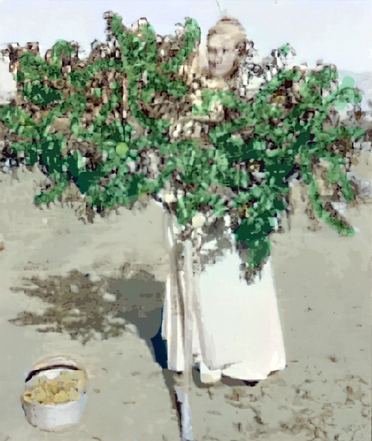Homesteading Hindrances
In the summer of 1913 Elmore went to the Land Office in Los Angeles to submit his "final proof" for his homestead, and while there he learned that his claim was being suspended because he did not have his Army discharge papers. He was given 30 days to appeal the action, but for some reason he did not do it, and the following December the claim was rejected.
However, there was a hand-scribbled note in his file giving the unit Elmore had served in, so he evidently had provided the information, probably by telephone. Finally, on January 26, 1914, the Land Office wrote the War Department to request a copy of Elmore's military record in order to certify his final proof.
This suspension was according to the rules, but seems unfair because there were emigrants practically fresh off the boat who were getting free government land, and here was Elmore H. Corwin, a decorated Civil War veteran who had a Purple Heart, with his homestead process tied up in bureaucratic red tape.
He obviously had lost his paperwork somewhere in the intervening 48 years since the war's end, perhaps in the fire of 1912 that destroyed his house. The Land Office shortly received a copy of his war record on February 9, 1914, and that very day a Certificate of Homestead was issued. Even so, it was not until July 8, 1914, that the 67-year-old pioneer received his land patent for the 160 acres.
During these five years of improving his homestead, Elmore was not content with just seeing his own ranch grow; he also was anxious to see growth in the valley and new homesteads around him. However, there was an obstacle to that goal--a big one: development was being obstructed by the railroad grants that checkerboarded most of the area.
This was an issue with Elmore, as well as other settlers in Apple Valley, and a letter in Elmore's Land Office file, dated November 11, 1910, shows his concern. "I have a Homestead in [Apple Valley]," he wrote, "and am bounded on all sides of the Sec. by these R. R. Sections upon which no settlement or work of any kind has ever been done, certainly a great hindrance and drawback to the progress and development of the valley."
Railroads were held in low esteem at this time by the average person. It was felt their owners were greedy and that pricing policies gouged the customers, especially the small farmers.
The Victor Portland Cement Company had challenged the ownership of several hundred acres of Southern Pacific Railway land in the Victor Valley area in May 1910. The Government Land Office rebuffed the challenge, and the case entered the court system. The Southern Pacific eventually won, but it took several years of litigation. Much of this railroad land lying east of the Mojave River was later bought by Newton Bass and his partner after World War II, and is the property they developed into Apple Valley Ranchos.
BACK
Index| 1| 2| 3| 4| 5| 6| 7| 8| 9| 10
NEXT
Harriet Corwin gathering peaches
Victor Valley College Photo